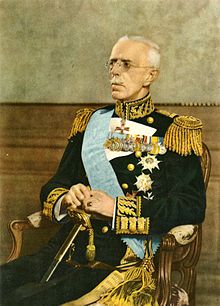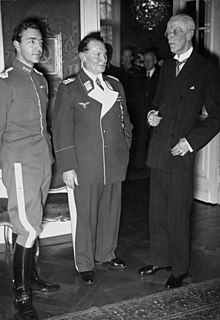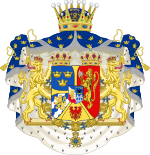Gustaf V
This article needs additional citations for verification. (January 2010) |
| Gustaf V | |||||
|---|---|---|---|---|---|
 | |||||
| King of Sweden | |||||
| Reign | 8 December 1907 – 29 October 1950 | ||||
| Predecessor | Oscar II | ||||
| Successor | Gustaf VI Adolf | ||||
| Prime Ministers | |||||
| Born | 16 June 1858 Drottningholm Palace | ||||
| Died | 29 October 1950 (aged 92) Drottningholm Palace | ||||
| Burial | |||||
| Spouse | |||||
| Issue | Gustaf VI Adolf of Sweden Prince Vilhelm, Duke of Södermanland Prince Erik, Duke of Västmanland | ||||
| |||||
| House | Bernadotte | ||||
| Father | Oscar II of Sweden | ||||
| Mother | Sofia of Nassau | ||||
| Religion | Church of Sweden | ||||

Gustaf V (Oscar Gustaf Adolf 16 June 1858 – 29 October 1950) was King of Sweden from 1907 to 1950. He was the eldest son of King Oscar II of Sweden and Sophia of Nassau, a half-sister of Adolphe, Grand Duke of Luxembourg. Reigning from the death of his father Oscar II in 1907 until his own death 43 years later, he holds the record of being the oldest monarch of Sweden and the second-longest reigning after Magnus IV (Gustaf V was still the longest as an adult). He was also the last Swedish monarch to exercise his royal prerogatives, which largely died with him, although formally abolished only with the remaking of the Swedish constitution in 1974. He was the first Swedish king since the High Middle Ages not to have a coronation and hence never wore a crown, a tradition continuing to date.
Gustaf's early reign saw the rise of parliamentary rule in Sweden, although the leadup to World War I pre-empted his overthrow of Liberal Prime Minister Karl Staaff in 1914, replacing him with his own figurehead Hjalmar Hammarskjöld (father of Dag Hammarskjöld) for most of the war. However, after the Liberals and Social Democrats secured a parliamentary majority under Staaff's successor, Nils Edén, he allowed Edén to form a new government which de facto stripped the monarchy of all virtual powers and enacted universal and equal suffrage, including for women, by 1919. Bowing fully to the principles of parliamentary democracy, he remained a popular figurehead for the remaining 31 years of his rule, although not completely without influence – during World War II he allegedly urged Per Albin Hansson's coalition government to accept requests from Nazi Germany for logistics support, refusing which might have provoked an invasion. This remains controversial to date, although he is not known to have shown much support for fascism or radical nationalism; his pro-German and anti-Communist stance was well known also in World War I.
Following his death at age 92, he was implicated as a homosexual in the Haijby affair. His supposed lover – career criminal and accused pedophile Kurt Haijby – was imprisoned in 1952 for blackmail of the court in the 1930s. (Homosexuality was a criminal offense in Sweden until 1944, though Gustaf's position would have granted automatic immunity.) An avid hunter and sportsman, he presided over the 1912 Olympic Games and chaired the Swedish Association of Sports from 1897 to 1907. Most notably, he represented Sweden (under the alias of Mr G.) as a competitive tennis player, keeping up competitive tennis until his 80s, when his eyesight deteriorated rapidly.[1][2]
Early life
Gustaf V was born in Drottningholm Palace in Ekerö, Stockholm County, the son of Prince Oscar and Princess Sofia. At birth Gustaf was created Duke of Värmland. Upon his father's accession to the throne in 1872, Gustaf became crown prince of both Sweden and Norway. On 8 December 1907, he succeeded his father on the Swedish throne, which had been separated from the Norwegian throne two years earlier.
On 20 September 1881 he married Princess Victoria of Baden in Karlsruhe, Germany. She was the granddaughter of Princess Sophie of Sweden, and her marriage to Gustaf V united, by a real blood link (and not only adoption), the reigning Bernadotte dynasty with the former royal house of Holstein-Gottorp.
Public life

When he ascended the throne, Gustaf V was, at least on paper, a near-autocrat. The 1809 Instrument of Government made the king both head of state and head of government, and ministers were solely responsible to him. However, his father had been forced to accept a government chosen by the majority in Parliament in 1905. Since then, prime ministers had been chosen according to parliamentary support.
At first, Gustaf V seemed to be willing to accept parliamentary rule. After the Liberals won a massive landslide in 1911, Gustaf appointed Liberal leader Karl Staaff as Prime Minister. However, during the runup to World War I, the elites objected to Staaff's defence policy. In February 1914, a large crowd of farmers gathered at the royal palace and demanded that the country's defences be strengthened. In his reply, the so-called Courtyard Speech--which was actually written by explorer Sven Hedin, an ardent conservative--Gustaf promised to strengthen the country's defences. Staaff was outraged, telling the king parliamentary rule called for the Crown to stay out of partisan politics. He was also angered that he had not been consulted in advance of the speech. However, Gustaf retorted that he still had the right to "communicate freely with the Swedish people." The Staaff government resigned in protest, and Gustaf appointed a government of civil servants headed by Hjalmar Hammarskjöld (father of Dag Hammarskjöld) in its place. To date, it is the last time that a Swedish king directly intervened in the governing of the country.
The 1917 elections showed a heavy gain for the Liberals and Social Democrats. Despite this, Gustaf initially tried to appoint a Conservative government headed by Johan Widén. However, Widén was unable to form a coalition. It was now apparent that Gustaf could no longer appoint a government entirely of his own choosing, nor could he keep a government in office against the will of Parliament. With no choice but to appoint a Liberal as prime minister, he appointed a Liberal-Social Democratic coalition government headed by Staaff's successor as Liberal leader, Nils Edén. The Edén government promptly arrogated most of the king's political powers to itself and enacted numerous reforms, most notably the institution of complete (male and female) universal suffrage in 1918–1919. While Gustaf still formally appointed the ministers, they now had to have the confidence of Parliament. He was now also bound to act on the ministers' advice. Although the provision in the Instrument of Government stating that "the King alone shall govern the realm" remained unchanged, for all intents and purposes the ministers did the actual governing. Gustaf accepted his reduced role, and reigned for the rest of his life as a model limited constitutional monarch. Parliamentarianism had become a de facto reality in Sweden, even if it would not be formalized until 1974.
Gustaf V was considered to have German sympathies during World War I. His political stance during the war was highly influenced by his wife, who felt a strong connection to her German homeland. On 18 December 1914, he sponsored a meeting in Malmö with the other two kings of Scandinavia to demonstrate unity. Another of Gustaf V's objectives was to dispel suspicions that he wanted to bring Sweden into the war on Germany's side.
Nazi sympathies

Both the King and his grandson Prince Gustav Adolf socialized with certain Nazi leaders before World War II, though arguably for diplomatic purposes. Gustaf V attempted to convince Hitler during a visit to Berlin to soften his persecution of the Jews, according to historian Jörgen Weibull. He was also noted for appealing to the leader of Hungary to save its Jews "in the name of humanity." At the behest of American President Franklin D. Roosevelt, Gustaf V appealed to Hitler for peace negotiations in 1938, "in the interest of peace".[citation needed]
When Nazi Germany invaded the Soviet Union in June 1941, Gustaf V tried to write a private letter to Hitler thanking him for taking care of the "Bolshevik pest" and congratulating him on his "already achieved victories".[3] He was stopped from doing so by the Prime Minister Hansson. Nevertheless, the King sent the message to Hitler (through a telegram by the German embassy in Stockholm) behind the back of the Government.[citation needed]
Midsummer crisis 1941
According to Prime Minister Per Albin Hansson during the Midsummer crisis, the King in a private conversation had threatened to abdicate if the Government did not approve a German request to transfer a fighting infantry division – the so-called Engelbrecht Division – through Swedish territory from southern Norway to northern Finland in June 1941, around Midsummer. The accuracy of this claim is debated, and the King's intention (if he did in fact make this threat) is sometimes alleged to be his desire to avoid conflict with Germany. This event has later received considerable attention from Swedish historians and is known as midsommarkrisen, the Midsummer Crisis.[4]
Confirmation of the King's action is contained in German Foreign Policy documents captured at the end of the war. On 25 June 1941, the German Minister in Stockholm sent a "Most Urgent-Top Secret" message to Berlin in which he stated that the King had just informed him that the transit of German troops would be allowed. He added:
The King's words conveyed the joyful emotion he felt. He had lived through anxious days and had gone far in giving his personal support to the matter. He added confidentially that he had found it necessary to go so far as to mention his abdication.[5]
According to Ernst Wigforss, both Gustaf V and Prince Gustav Adolf attempted to persuade the Swedish Government to allow the Allies to transport troops through Sweden, though this was rejected by the Government because it was felt it would cause retributions from Germany.[citation needed]
Personal life
Gustaf V was thin, and famed for his great height. He wore pince-nez eyeglasses and sported a pointed mustache for most of his teen years.
Gustaf V was a devoted tennis player, appearing under the pseudonym Mr G. As a player and promoter of the sport, he was elected into the International Tennis Hall of Fame in 1980. The King learned the sport during a visit in Britain in 1876 and founded Sweden's first tennis club on his return home. In 1936 he founded the King's Club. During his reign, Gustaf was often seen playing on the Riviera. On a visit to Berlin, Gustaf went straight from a meeting with Hitler to a tennis match with the Jewish player Daniel Prenn. During World War II, he interceded to obtain better treatment for Davis Cup stars Jean Borotra of France and Gottfried von Cramm of Germany, who had been imprisoned by the German Government.
Haijby affair
Allegations of a love affair between Gustav and Kurt Haijby led to the court paying 170,000 kronor under threat of blackmail by Haijby. This led to the so-called Haijby affair and several criticized trials and convictions against Haijby which spawned considerable controversy about Gustav's alleged homosexuality.[6]
Death
After a reign of nearly 43 years, King Gustaf V died in Stockholm, due to flu complications on 29 October 1950.
Titles and arms
- 16 June 1858 – 18 September 1872: His Royal Highness Prince Gustaf, The Duke of Värmland, Prince of Sweden and Norway
- 18 September 1872 – 7 June 1905: His Royal Highness Prince Gustaf, The Crown Prince of Sweden and Norway, Duke of Värmland
- 7 June 1905 – 8 December 1907: His Royal Highness Prince Gustaf, The Crown Prince of Sweden, Duke of Värmland
- 8 December 1907 – 29 October 1950: His Majesty King Gustaf V, The King of Sweden
Upon his creation as Duke of Värmland, Gustaf V was granted a coat of arms with the Arms of Värmland in base. Upon his accession to the throne, he assumed the Arms of Dominion of Sweden.
 |
 |
 |
 |
Honours
Foreign Honours
King Gustaf V was the 1,062nd Knight of the Order of the Golden Fleece in Spain, the 828th Knight of the Order of the Garter in 1905 and the 216th Grand Cross of the Order of the Tower and Sword.
 United Kingdom 828th Knight of the Garter 1906.[7]
United Kingdom 828th Knight of the Garter 1906.[7] United Kingdom Honorary Knight Grand Cross (Civil) of the Order of the Bath 19 February 1901[8]
United Kingdom Honorary Knight Grand Cross (Civil) of the Order of the Bath 19 February 1901[8] United Kingdom Royal Victorian Chain
United Kingdom Royal Victorian Chain
Issue
| Name | Birth | Death | Notes |
|---|---|---|---|
| King Gustaf VI Adolf of Sweden | 11 November 1882 | 15 September 1973 | married 1) Princess Margaret of Connaught (1882–1920), had issue (four sons, one daughter), married 2) Lady Louise Mountbatten (1889–1965), had issue (a stillborn daughter) |
| Prince Vilhelm of Sweden, Duke of Södermanland | 17 June 1884 | 5 June 1965 | married Grand Duchess Maria Pavlovna of Russia (1890–1958), had issue |
| Prince Erik of Sweden, Duke of Västmanland | 20 April 1889 | 20 September 1918 | died unmarried of the Spanish Flu, no issue |
Ancestors
See also
- 1912 Summer Olympics, which he opened
References
- ^ http://www.ne.se/lang/gustaf-v
- ^ http://www.ne.se/lang/haijbyaff%C3%A4ren
- ^ Dagens Nyheter 070729 [1][dead link]
- ^ Hansson (Wahlbäck, Regeringen och kriget. Ur statsrådens dagböcker 1939–41)
- ^ Documents of German Foreign Policy 1918–1945 Series D Volume XIII The War Years 23 June 1941 – 11 December 1941, Published in UK by HMSO and in US By Government Printing Office.
- ^ Heumann, Maths (1978). Rättsaffärerna Kejne och Haijby (in Swedish). Stockholm: Norstedt. ISBN 91-1-787202-2.
- ^ "Garter Knights Meet in Splendid Ceremony ... King Kaakon is Invested," New York Times. 25 November 1906.
- ^ "No. 27286". The London Gazette. 19 February 1901.
External links
- Gustaf V profile at the International Tennis Hall of Fame website
- . . 1914.
- . Encyclopædia Britannica (11th ed.). 1911.
- Use dmy dates from April 2012
- People from Ekerö Municipality
- Dukes of Värmland
- House of Bernadotte
- Knights of the Golden Fleece
- Knights of the Order of the Norwegian Lion
- LGBT people from Sweden
- LGBT tennis players
- Bisexual sportspeople
- Bisexual royalty
- Protestant monarchs
- Recipients of the Order of the Black Eagle
- Recipients of the Royal Victorian Chain
- Swedish Lutherans
- Swedish monarchs
- Swedish male tennis players
- International Tennis Hall of Fame inductees
- Uppsala University alumni
- World War II political leaders
- Swedish people of French descent
- Swedish monarchs of German descent
- Crown Princes of Sweden
- 1858 births
- 1950 deaths
- Burials at Riddarholmen Church
- Extra Knights Companion of the Garter
- Honorary Knights Grand Cross of the Royal Victorian Order
- Grand Crosses of the Order of the Tower and Sword
- Grand Commanders of the Order of the Dannebrog
- Recipients of the Silver Wolf Award
- Knights Grand Cross of the Order of the Crown (Württemberg)
- Honorary Knights Grand Cross of the Order of the Bath
